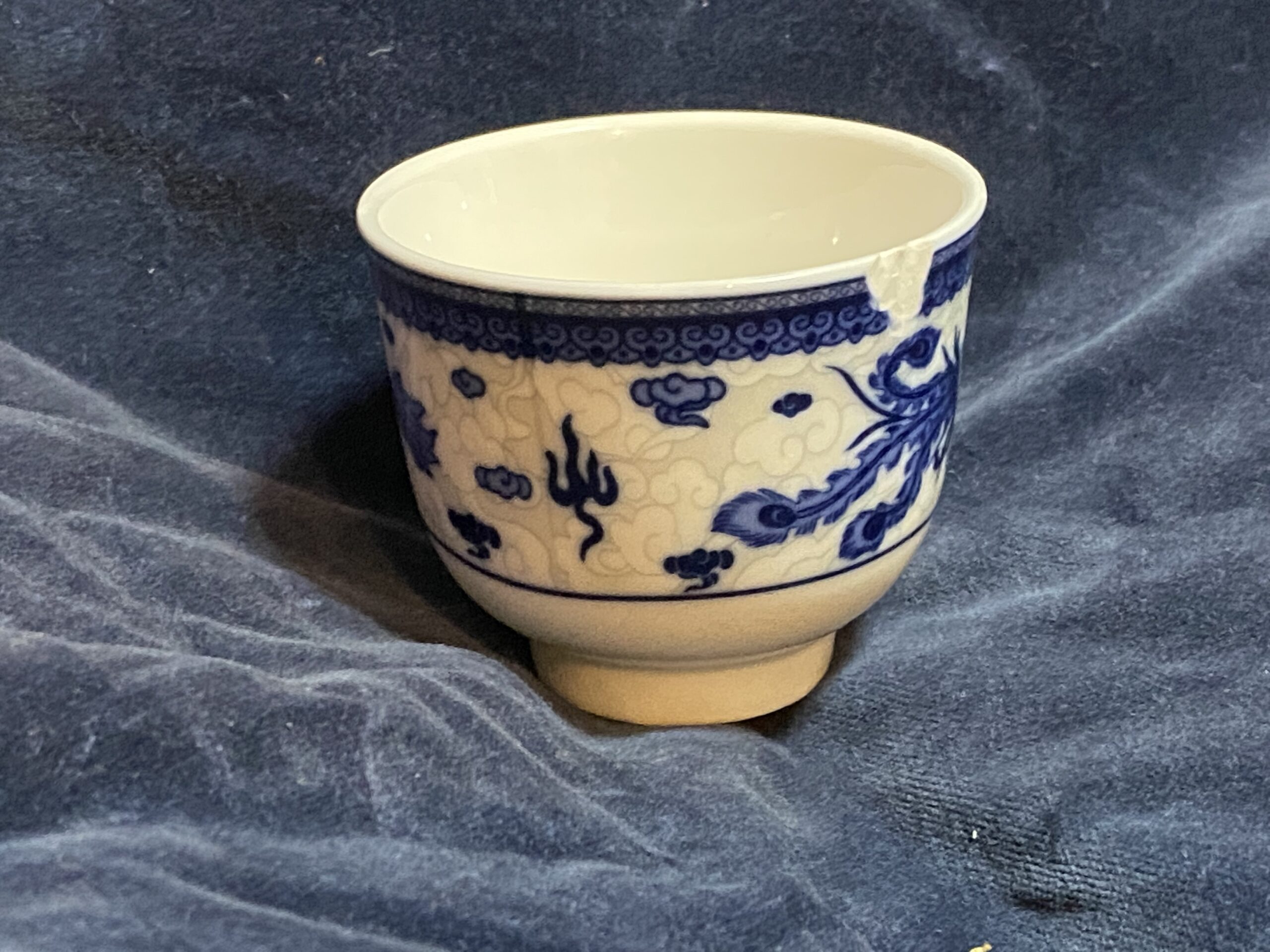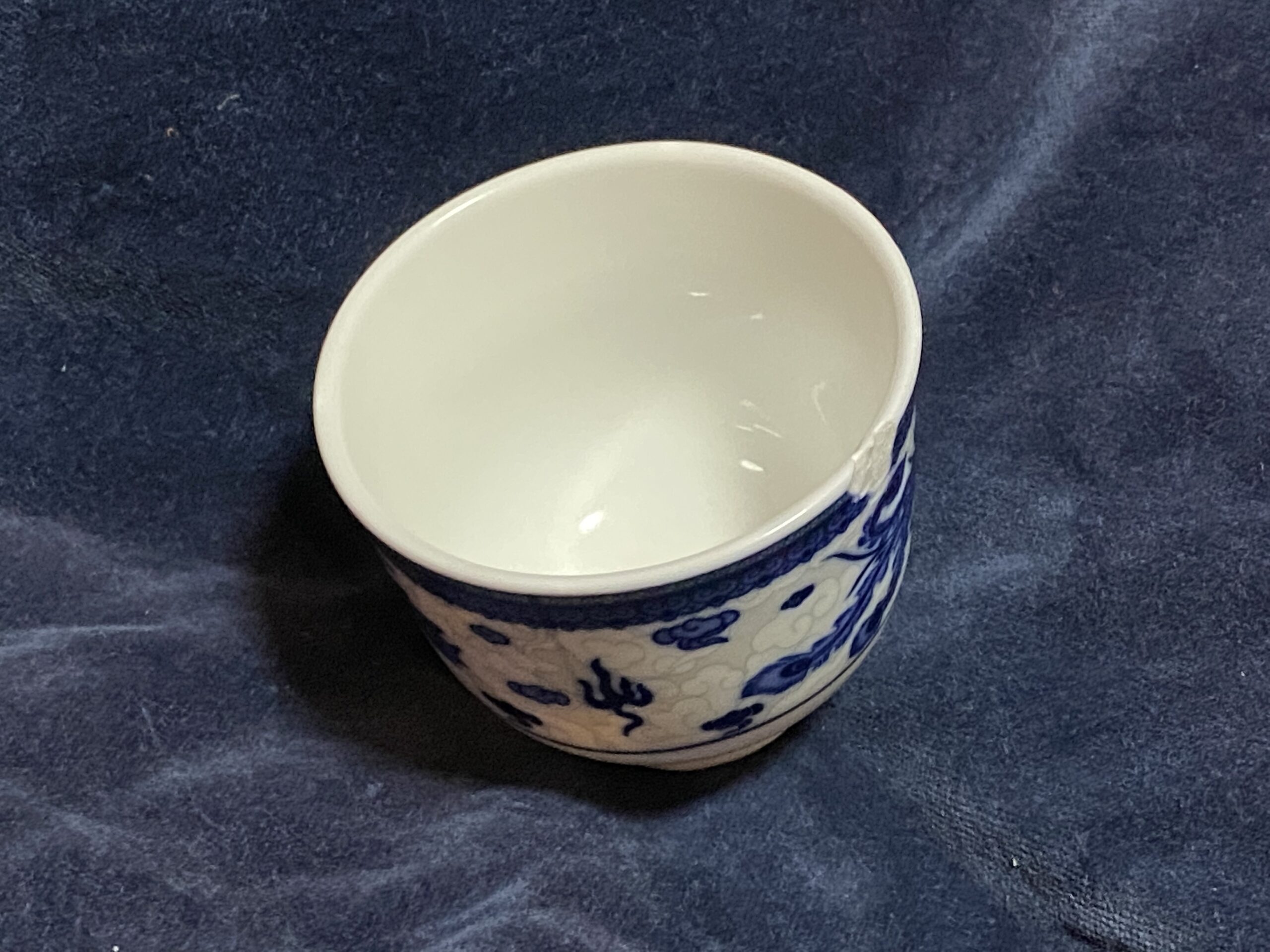Asian teacup with dragon design (Chinese restaurant style, unmarked): 32 ppm Lead + 11 ppm Cadmium (safe by all standards.)
XRF test results for cup pictured
Reading #1) On white of cup
60-second reading
- Lead (Pb): 32 +/- 4 ppm
- Cadmium (Cd): 11 +/- 2 ppm
- Mercury (Hg): non-detect
- Bromine (Br): non-detect
- Chromium (Cr): non-detect
- Iron (Fe): 3,968 +/- 95 ppm
- Zinc (Zn): 39 +/- 6 ppm
- Niobium (Nb): 286 +/- 8 ppm
- Indium (In): 11 +/- 3 ppm
- Tin (Sn): 13 +/- 3 ppm
- Platinum (Pt): 37 +/- 12 ppm
- Bismuth (Bi): 72 +/- 5 ppm
- No other metals detected in consumer goods mode.
Reading #2) On blue of design
60-second reading
- Lead (Pb): 26 +/- 4 ppm
- Cadmium (Cd): 4 +/- 2 ppm
- Mercury (Hg): non-detect
- Bromine (Br): non-detect
- Chromium (Cr): 1,285 +/- 113 ppm
- Iron (Fe): 3,998 +/- 85 ppm
- Cobalt (Co): 20,700 +/- 200 ppm
- Zinc (Zn): 35 +/- 5 ppm
- Tin (Sn): 8 +/- 3 ppm
- Platinum (Pt): 20 +/- 11 ppm
- Bismuth (Bi): 48 +/- 4 ppm
- No other metals detected in consumer goods mode.
For those new to this website:
Tamara Rubin is a Federal-award-winning independent advocate for consumer goods safety and a documentary filmmaker. She is also a mother of Lead-poisoned children. Tamara’s sons were acutely Lead-poisoned in August of 2005. She began testing consumer goods for toxicants in 2009 and was the parent-advocate responsible for finding Lead in the popular fidget spinner toys in 2017. Tamara uses XRF testing (a scientific method used by the U.S. Consumer Product Safety Commission) to test consumer goods for toxicants (specifically heavy metals), including Lead, Cadmium, Mercury, Antimony, and Arsenic. All test results reported on this website are science-based, accurate, and replicable. Items are tested multiple times, to confirm the test results for each component tested. Please click through to this link to learn more about the testing methodology used for the test results discussed and reported on this website.



Never Miss an Important Article Again!
Join our Email List





I’d it possible to get the brand name of the tea cup—to help avoid it?
Sandy
If you look at all of the images there is no maker’s mark or brand noted.
Thanks—I wanted to double check as I saw no brand. Would you consider doing drip coffee makers please? Many are made with plastic and aluminum and partial stainless steel.
Tamara —Hi! I’ve searched your entire site about teacups and read all of your articles on teacups.just wanted to preface that as I’m not one of those newbies that just bug the crap out of you without searching the site. And reading.
All that being said, I just have one question:
Is there a teacup you recommend that is lead free and safe? And do you have a link, so I can be sure to purchase the correct one that is safe?
My daughter likes to drink chamomile tea and I want to be sure there is no lead or anything in any tea cup I purchase. I know you say Glass is best, but there’s so many Glass teacups out there, that I am not sure which one to choose. Ball doesn’t make any that I know of. Anchor Hocking has some to purchase on eBay from mid century (Wexford design). But I don’t know if they are safe either as they are older and have no stamps. They have chiseled designs on them as well. Since it’s my child I want to be especially safe. I only need one or 2 but thought it would make tea time more fun for her. I do know you showed a Child’s teaset, but I can’t find it. Thanks for your help.
Thank you – the clear glass McDonald’s mugs are made by Princess House and are lead-free and have some fun designs – you may want to check those out. Another option might be a blue and white Japanese tea set made for the Japanese market (so it doesn’t say “Made in Japan” on the bottom – but has Japanese characters instead) – you might be able to find something like that at a local store. I have a tea set for children that I plan on testing when I get home – purchased in the last year… but I won’t be able to report on that until at least late-September.
The ForLife ones are leach tested but they are not lead-free…
https://tamararubin.com/2019/05/one-of-my-most-disappointing-finds-recently-2019-forlife-q-tea-cup-with-handle-purple-lead-free-mug-541-ppm-lead/